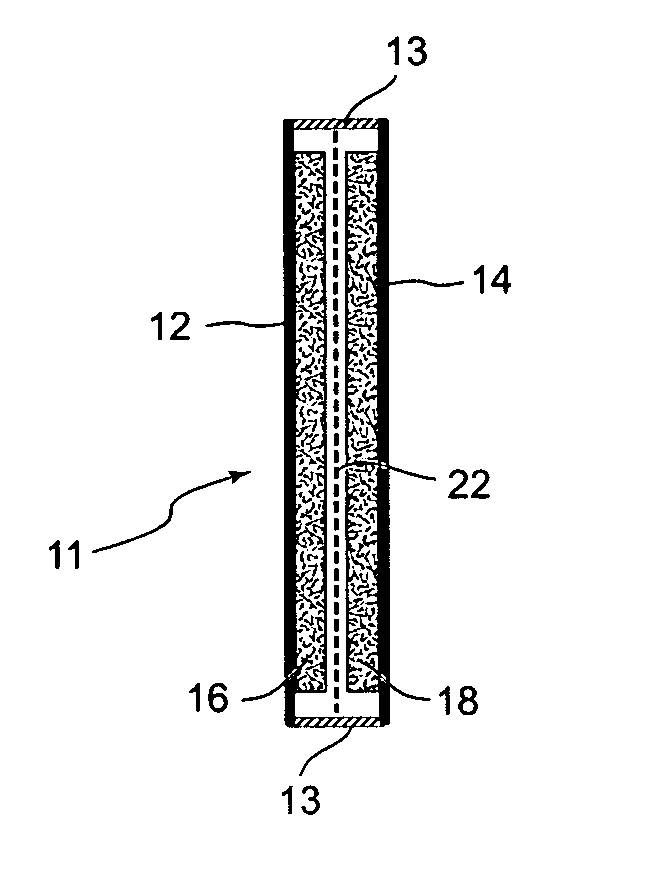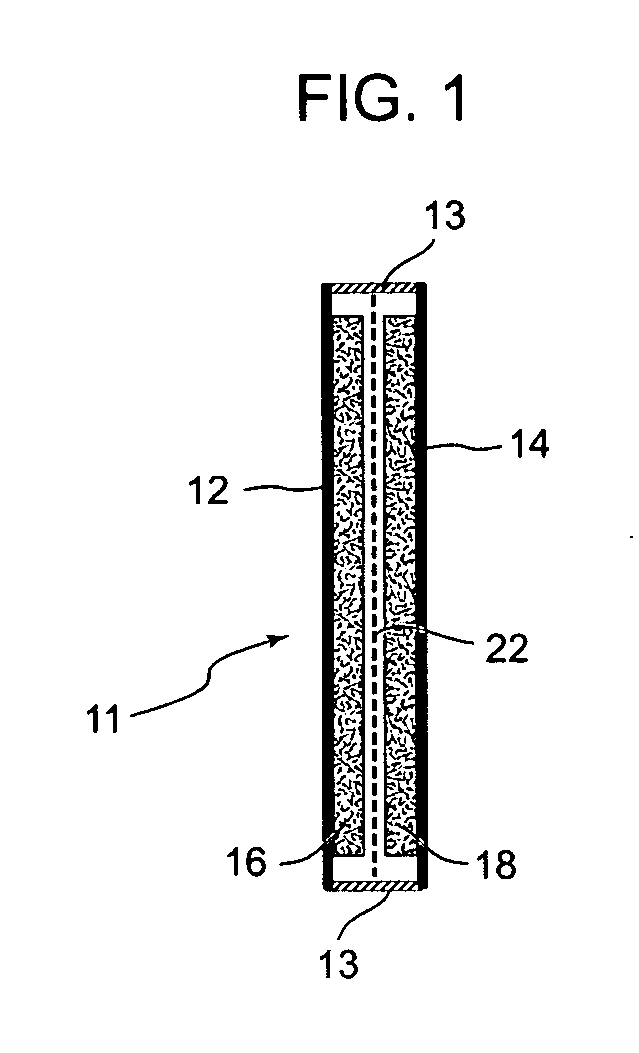High energy density electric double-layer capacitor and method for producing the same
- Summary
- Abstract
- Description
- Claims
- Application Information
AI Technical Summary
Benefits of technology
Problems solved by technology
Method used
Image
Examples
example 1
[0048] Petroleum coke is ground to a fine powder and then pyrolyzed in an anoxic furnace at 900° C. for 3 hours to remove volatile content and increase the graphitic regions in the carbon. The resulting graphitic carbon is then ground to fine powder again. The graphitic powder is mixed with a low melt flow phenol-hexamethylene tetramine resin (Plenco) powder with a mass ratio of 70:30 respectively. The resulting mix is pressed in a hydraulic die at 600 PSI pressure at 150° C. forming a solid self-bound electrode pre-form. This composite electrode is then mixed with a sodium hydroxide in a 1:1 mass ratio and “activated” by heating in an anoxic furnace at 850° C. The result leaves the graphitic carbon intercalated with alkali metal, while not substantially changing the amorphous or glassy carbon portion formed by the phenolic binder. The electrodes are then further washed in water to remove the excess alkali metal, and then dried to prepare them for integration into a capacitor. The w...
example 2
[0050] Coconut shell is ground to a fine powder and then pyrolyzed in an anoxic furnace at 1700° C. for 2 hours to remove volatile content and increase the graphitic regions in the carbon. The resulting graphitic carbon is then ground into a fine powder again. The graphitic powder is mixed with a cellulose powder having a mass ratio of 80:20 respectively. Water is added to the resulting mix and pressed in a hydraulic die at 600 PSI pressure at 208° C. for 3 minutes, creating steam, converting some of the cellulose to furfurals and crosslinking, and forming a solid self-bound electrode pre-form. This composite electrode is then mixed with potassium hydroxide in a 1:2 mass ratio and “activated” by heating in an anoxic furnace at 900° C. The result leaves the graphitic carbon intercalated with the alkali metal. The electrodes are then further washed in water to remove the excess alkali metal, and then dried to prepare them for integration into a capacitor.
[0051] Two such electrodes ar...
example 3
[0052] Cellulose is ground to a fine powder and water added to moisten the cellulose. The cellulose mixture is pressed in a hydraulic die at 300 PSI pressure at 208° C. for 3 minutes, creating steam and converting some of the cellulose to furfurals, polymerizing and crosslinking the cellulose, which forms a solid porous self-bound electrode pre-form. The electrode pre-form is then pyrolyzed in an anoxic furnace at 1700° C. for 2 hours to remove volatile content and increase the graphitic regions in the carbon. This electrode is then mixed with potassium hydroxide in a 1:1 mass ratio and “activated” by heating in an anoxic furnace at 900° C. The result leaves the graphitic carbon intercalated with the alkali metal. The electrodes are then further washed in water to remove the excess alkali metal, and then dried to prepare them for integration into a capacitor.
[0053] Two such electrodes are bonded to aluminum collectors, and with a microporous polypropylene separator interposed betwe...
PUM
 Login to View More
Login to View More Abstract
Description
Claims
Application Information
 Login to View More
Login to View More - R&D
- Intellectual Property
- Life Sciences
- Materials
- Tech Scout
- Unparalleled Data Quality
- Higher Quality Content
- 60% Fewer Hallucinations
Browse by: Latest US Patents, China's latest patents, Technical Efficacy Thesaurus, Application Domain, Technology Topic, Popular Technical Reports.
© 2025 PatSnap. All rights reserved.Legal|Privacy policy|Modern Slavery Act Transparency Statement|Sitemap|About US| Contact US: help@patsnap.com



